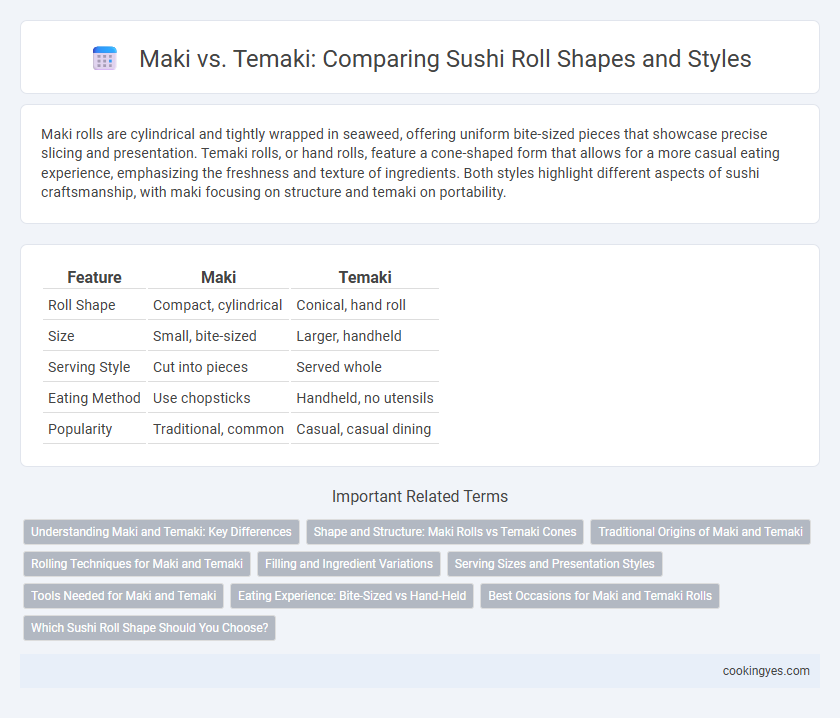Maki rolls are cylindrical and tightly wrapped in seaweed, offering uniform bite-sized pieces that showcase precise slicing and presentation. Temaki rolls, or hand rolls, feature a cone-shaped form that allows for a more casual eating experience, emphasizing the freshness and texture of ingredients. Both styles highlight different aspects of sushi craftsmanship, with maki focusing on structure and temaki on portability.
Table of Comparison
| Feature | Maki | Temaki |
|---|---|---|
| Roll Shape | Compact, cylindrical | Conical, hand roll |
| Size | Small, bite-sized | Larger, handheld |
| Serving Style | Cut into pieces | Served whole |
| Eating Method | Use chopsticks | Handheld, no utensils |
| Popularity | Traditional, common | Casual, casual dining |
Understanding Maki and Temaki: Key Differences
Maki rolls are traditionally cylindrical, with sushi rice and fillings wrapped tightly in seaweed, creating bite-sized pieces ideal for uniform eating experiences. Temaki, or hand rolls, have a cone shape formed by rolling nori around the ingredients, offering a more casual and customizable sushi option. The main difference in shape influences both presentation and consumption, with Maki presenting a neat, sliced appearance and Temaki providing a handheld, larger portion.
Shape and Structure: Maki Rolls vs Temaki Cones
Maki rolls feature a cylindrical shape with rice and fillings tightly wrapped in nori, creating a compact structure that is easy to slice and serve. Temaki cones have a distinct hand-rolled cone shape, offering a casual, open-ended experience that allows for more varied ingredient placement and texture. The structural difference affects the eating method, with maki providing bite-sized uniform pieces and temaki offering a customizable, handheld option.
Traditional Origins of Maki and Temaki
Maki, traditionally originating from the Edo period in Japan, features cylindrical rolls made by spreading rice and fillings on seaweed and slicing it into bite-sized pieces. Temaki, also known as hand rolls, emerged as an informal, easy-to-eat sushi shaped like a cone, designed for handheld consumption without cutting. Both styles reflect unique cultural purposes: Maki for formal dining presentation and Temaki for casual, portable enjoyment.
Rolling Techniques for Maki and Temaki
Maki rolls are crafted by spreading sushi rice and fillings evenly on a nori sheet, then tightly rolled using a bamboo mat to form a cylindrical shape, ensuring uniformity and compact texture. Temaki, or hand rolls, are shaped by folding a nori sheet into a cone and filling it with rice and ingredients, emphasizing an effortless, handheld eating experience with a open, tapered end. Mastery of rolling techniques directly influences the sushi's texture and presentation, with maki requiring precision and consistency, while temaki showcases a more casual, artisanal style.
Filling and Ingredient Variations
Maki rolls feature tightly wrapped rice and fillings with seaweed on the outside, allowing for precise ingredient layering such as cucumber, avocado, and various seafood, creating a compact bite-size shape. Temaki hand rolls are cone-shaped with loosely packed fillings like crab, spicy tuna, and fresh vegetables, offering more room for generous and diverse ingredient combinations. The distinct shapes influence texture and flavor distribution, with Maki emphasizing uniformity and Temaki providing a customizable eating experience.
Serving Sizes and Presentation Styles
Maki sushi features bite-sized, cylindrical rolls typically cut into six to eight pieces, offering a uniform serving size ideal for sharing and elegant plating. Temaki, on the other hand, presents a hand-rolled cone shape that's larger and more casual, designed for individual consumption with a dynamic, visually striking presentation. Both styles highlight the freshness of ingredients, but maki's symmetry suits formal dining while temaki emphasizes personalized, interactive eating experiences.
Tools Needed for Maki and Temaki
Maki rolls require a bamboo sushi mat (makisu) to evenly shape and tightly roll the ingredients into a cylinder, ensuring uniformity and ease of slicing. Temaki rolls, known as hand rolls, do not need specialized tools, as they are shaped by hand into a cone, allowing for a more casual and customizable preparation. The simplicity of Temaki contrasts with the precision tools essential for perfect Maki roll formation.
Eating Experience: Bite-Sized vs Hand-Held
Maki rolls are bite-sized and typically eaten with chopsticks, offering a balanced blend of rice, seaweed, and fillings in each piece that enhances uniform flavor in every bite. Temaki, or hand rolls, are cone-shaped and designed to be held with hands, providing a more casual, interactive dining experience with a fresh, crunchy texture as the seaweed remains crisp. The choice between maki and temaki influences the texture and ease of eating, with maki favoring neat, consistent portions and temaki emphasizing a personalized, handheld approach.
Best Occasions for Maki and Temaki Rolls
Maki rolls, with their compact and uniform shape, are ideal for formal dinners and sushi platters where bite-sized precision is appreciated. Temaki rolls, featuring a hand-rolled cone shape, suit casual occasions, parties, and sushi bar settings where guests prefer a more interactive and relaxed dining experience. The choice between Maki and Temaki rolls often depends on the event's ambiance and the preferred ease of eating.
Which Sushi Roll Shape Should You Choose?
Maki rolls are cylindrical and tightly wrapped with seaweed, providing a compact bite ideal for balanced flavors and easy dipping. Temaki rolls, shaped like cones, offer a hand-held, casual experience with more visible filling, perfect for showcasing fresh ingredients. Choose maki for traditional, bite-sized precision or temaki for a more interactive, customizable sushi experience.
Maki vs Temaki for roll shape Infographic

 cookingyes.com
cookingyes.com